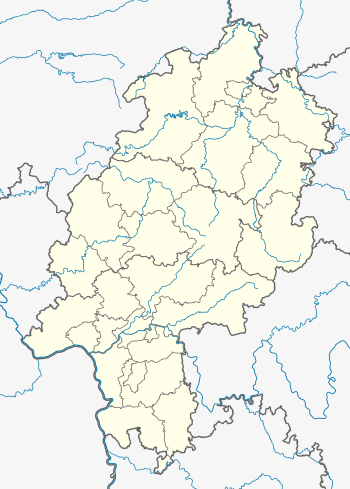Milseburg
| Milseburg | |
|---|---|
|
Milseburg | |
| Elevation | 835 m (2,740 ft) |
| Location | |
 Milseburg The location within Hesse | |
| Location | Hesse, Germany |
| Range | Rhön Mountains |
| Coordinates | 50°32′42″N 9°53′53″E / 50.54500°N 9.89806°ECoordinates: 50°32′42″N 9°53′53″E / 50.54500°N 9.89806°E |
The Milseburg is an extinct volcano and at 835 metres (2,740 ft) above sea level the second highest elevation in the Hessian part of the Rhön Mountains, Germany. The hill is located east of Fulda, near the villages of Kleinsassen and Danzwiesen.
Geography
The Milseburg is located in the municipality of Hofbieber, east of Fulda in the Rhön hills of Hesse, Germany. It is made up of volcanic basalt.[1] The headwaters of the creek Bieber, a contributor to the Haune are located immediately to the south of the Milseburg.
A nature reserve of around 26 hectares (created in the 1970s) covers most of the hill.[2]
Oppidum
The Milseburg is most notable, aside from being a landmark, for having been the site of an important Celtic oppidum. It was occupied from around 1200 to 800 BC and again from 450 BC to around the turn of the eras. The Ringwall (circular rampart) was one of the largest and most elevated in eastern Hesse. It originally had three gates, only one of which — the Tor am Kälberhutstein — was passable by wagons.[1]
Later history and name
One of several different versions of a Christian legend claims that the giant "Mils" who had allied himself to the devil used to live here. Saint Gangulphus vanquished the giant, who died. The devil then built a cairn for him with stones that outlined the giant's shape, feet to the north, head to the south. That supposedly created the trapezoid hill of Milseburg.[1]
The origin of the name Mils is not known for certain. In a document by Emperor Otto II from 980, the hill is already called Milsiburg. There was a small medieval castle on the western slope beneath the peak. Although it is only mentioned in a written document in 1119, it could have been built significantly earlier and given rise to the hill's name.[1]
Today
The hill was the property of Johann von und zu Guttenberg until 2005. That year, he sold it to the town of Hofbieber for €200,000. The State of Hesse contributed €52,000, the Fulda district another €10,000 to the purchase. The balance was made up by local businesses and individual donors. The Rhönklub has maintained a mountain cabin on the peak for over 100 years.[2] Nearby is the Gangolfskapelle a chapel dedicated to Saint Gangulphus. It is close to the location where the holy site of the Celts was likely situated. Since that area has not yet been excavated, no evidence of its existence has yet been found. Some small remains of the medieval castle are also still visible. At the highest point, there is a group of statues, showing a Crucifixion scene.[1]
The Milseburg also features Germany's longest cycling tunnel, a former part of the Rhönbahn railway.[3]
Milseburg is a popular destination for bikers and hikers.[1]
References
- ↑ 1.0 1.1 1.2 1.3 1.4 1.5 "Milseburg: Zwischen Himmel und Erde (German)". Mainpost. 12 October 2012. Retrieved 22 August 2014.
- ↑ 2.0 2.1 "Die Milseburg ist nicht mehr in Privatbesitz (German)". Die Welt. 29 December 2005. Retrieved 22 August 2014.
- ↑ "Milseburg - drunter und drüber (German)". Frankfurter Rundschau. 12 July 2007. Retrieved 22 August 2014.
See also
External links
| Wikimedia Commons has media related to Milseburg. |